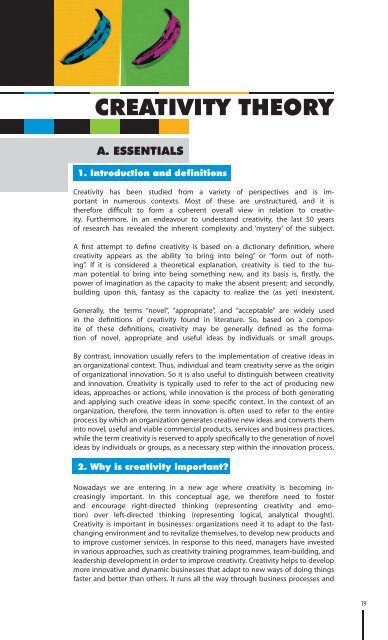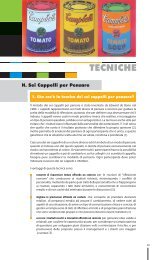Creativity Theory - TRaining MAterial in Creativity and InnovaTion ...
Creativity Theory - TRaining MAterial in Creativity and InnovaTion ...
Creativity Theory - TRaining MAterial in Creativity and InnovaTion ...
Create successful ePaper yourself
Turn your PDF publications into a flip-book with our unique Google optimized e-Paper software.
CREATIVITY THEORY<br />
A. ESSENTIALS<br />
1. Introduction <strong>and</strong> def<strong>in</strong>itions<br />
<strong>Creativity</strong> has been studied from a variety of perspectives <strong>and</strong> is important<br />
<strong>in</strong> numerous contexts. Most of these are unstructured, <strong>and</strong> it is<br />
therefore difficult to form a coherent overall view <strong>in</strong> relation to creativity.<br />
Furthermore, <strong>in</strong> an endeavour to underst<strong>and</strong> creativity, the last 50 years<br />
of research has revealed the <strong>in</strong>herent complexity <strong>and</strong> ‘mystery’ of the subject.<br />
A first attempt to def<strong>in</strong>e creativity is based on a dictionary def<strong>in</strong>ition, where<br />
creativity appears as the ability ‘to br<strong>in</strong>g <strong>in</strong>to be<strong>in</strong>g” or “form out of noth<strong>in</strong>g”.<br />
If it is considered a theoretical explanation, creativity is tied to the human<br />
potential to br<strong>in</strong>g <strong>in</strong>to be<strong>in</strong>g someth<strong>in</strong>g new, <strong>and</strong> its basis is, firstly, the<br />
power of imag<strong>in</strong>ation as the capacity to make the absent present; <strong>and</strong> secondly,<br />
build<strong>in</strong>g upon this, fantasy as the capacity to realize the (as yet) <strong>in</strong>existent.<br />
Generally, the terms “novel”, “appropriate”, <strong>and</strong> “acceptable” are widely used<br />
<strong>in</strong> the def<strong>in</strong>itions of creativity found <strong>in</strong> literature. So, based on a composite<br />
of these def<strong>in</strong>itions, creativity may be generally def<strong>in</strong>ed as the formation<br />
of novel, appropriate <strong>and</strong> useful ideas by <strong>in</strong>dividuals or small groups.<br />
By contrast, <strong>in</strong>novation usually refers to the implementation of creative ideas <strong>in</strong><br />
an organizational context. Thus, <strong>in</strong>dividual <strong>and</strong> team creativity serve as the orig<strong>in</strong><br />
of organizational <strong>in</strong>novation. So it is also useful to dist<strong>in</strong>guish between creativity<br />
<strong>and</strong> <strong>in</strong>novation. <strong>Creativity</strong> is typically used to refer to the act of produc<strong>in</strong>g new<br />
ideas, approaches or actions, while <strong>in</strong>novation is the process of both generat<strong>in</strong>g<br />
<strong>and</strong> apply<strong>in</strong>g such creative ideas <strong>in</strong> some specific context. In the context of an<br />
organization, therefore, the term <strong>in</strong>novation is often used to refer to the entire<br />
process by which an organization generates creative new ideas <strong>and</strong> converts them<br />
<strong>in</strong>to novel, useful <strong>and</strong> viable commercial products, services <strong>and</strong> bus<strong>in</strong>ess practices,<br />
while the term creativity is reserved to apply specifically to the generation of novel<br />
ideas by <strong>in</strong>dividuals or groups, as a necessary step with<strong>in</strong> the <strong>in</strong>novation process.<br />
2. Why is creativity important?<br />
Nowadays we are enter<strong>in</strong>g <strong>in</strong> a new age where creativity is becom<strong>in</strong>g <strong>in</strong>creas<strong>in</strong>gly<br />
important. In this conceptual age, we therefore need to foster<br />
<strong>and</strong> encourage right-directed th<strong>in</strong>k<strong>in</strong>g (represent<strong>in</strong>g creativity <strong>and</strong> emotion)<br />
over left-directed th<strong>in</strong>k<strong>in</strong>g (represent<strong>in</strong>g logical, analytical thought).<br />
<strong>Creativity</strong> is important <strong>in</strong> bus<strong>in</strong>esses: organizations need it to adapt to the fastchang<strong>in</strong>g<br />
environment <strong>and</strong> to revitalize themselves, to develop new products <strong>and</strong><br />
to improve customer services. In response to this need, managers have <strong>in</strong>vested<br />
<strong>in</strong> various approaches, such as creativity tra<strong>in</strong><strong>in</strong>g programmes, team-build<strong>in</strong>g, <strong>and</strong><br />
leadership development <strong>in</strong> order to improve creativity. <strong>Creativity</strong> helps to develop<br />
more <strong>in</strong>novative <strong>and</strong> dynamic bus<strong>in</strong>esses that adapt to new ways of do<strong>in</strong>g th<strong>in</strong>gs<br />
faster <strong>and</strong> better than others. It runs all the way through bus<strong>in</strong>ess processes <strong>and</strong><br />
19



